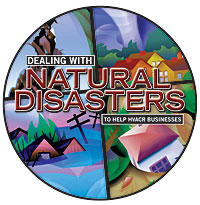
"We're running about 20 to 25 people out there who are actually in the field," said John Ferguson, an account executive for Carrier Commercial Services in Jackson, Miss. These crews have been working on "things that didn't get affected from water damage; a lot of things that are on the roof."
Crew Safety
Roof safety is being evaluated by means of visual inspections, he said. "There are certain areas, classified zones, that we don't even go into. If water is still standing, we don't go in. They don't have any power anyway."In contaminated regions, all of our technicians going down there are getting vaccinated for tetanus, typhoid, and hepatitis. We're not wearing HazMat gear, but we are carrying antibiotic stuff with us, wearing shoes, gloves, that sort of thing."
According to Ferguson, "The most unique thing for us is the fact that much of the equipment we previously worked on is no longer there - 5,000-pound pieces of equipment are just gone. The building structure is there but the equipment is gone. The equipment has been washed away.
"A lot of our customers told us that you cannot smell the damage on TV," he continued. "We're seeing humans in the water, animal carcasses everywhere, still floating around ... the debris is just tremendous."
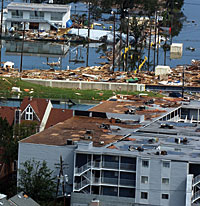
Housing is a major issue, commented Loren Reid with Munters Moisture Control Services. "The commutes are very bad. Sometimes the commutes are three hours each way. We have been struggling to find accommodations that have power and water. When [crews] get back at night, you don't want to have them in a situation where there's no A/C, water, or showers. That's asking too much of people.
"We plan on being down in the area for a long time, get folks back in the business as soon as possible."
Cleanup crew safety precautions now may need to include insecticide protection. According to officials with the U.S. Public Health Service and Federal Energy Management Association (FEMA), insecticide spraying planned for Sept. 12 should help reduce a growing population of mosquitoes, flies, and other disease-carrying insects. The chemical to be sprayed, naled ("Dibrom"), is said to kill adult insects.
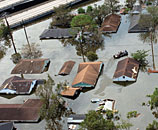
Drying Out
"We have several projects we are involved with around the New Orleans area," said Reid. "Most of the stuff around New Orleans is set up for archive records and that type of thing - casinos, some schools we are involved with, office buildings, etc."We have a staff of about 60 people down there now set up on several different fronts [Mobile Ala.; Jackson, Miss.; Slidell, La.] helping in restoration, mucking out the mud, this type of thing," Reid said. "We've been involved in archive recovery and the government has been very forthcoming with passes, access to areas, and understanding of the situation.
"Everybody has their own priorities. There has to be a rank order and obviously the first one is to take care of the people. We do what we can to retain the history of the area and restore the buildings that are recoverable. The history is in the buildings and the records, but the people really are the most important.
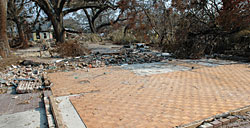
"We have an office in New Orleans, and thank God, it wasn't damaged too badly," Reid continued. "It was on higher ground in an industrial plaza close to the airport. Unfortunately, the guys there, with the best intentions, tried to hide the equipment that we couldn't move out, next to brick walls and the walls collapsed." Fortunately, "our equipment is very fluid," he said.
"There are 15,000 systems throughout the United States and we can move them around as we need." The company set up an operations center at the Crossroads Mall in Gulfport, Miss. "We set up a storage yard in New Iberia, La."
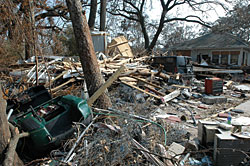
"All the other jobs are restoration jobs," Sarradet said, "mainly dehumidification equipment powered by a portable generator."
Keith Coursin, president of Desert Aire, told The News, "We're getting phone calls from people representing a number of building types. Hotels are looking for equipment to begin drying out hotel rooms just to accommodate the disaster relief crews that are there for relief assistance. The FEMA office has also inquired as to how to dry out data and telephone centers, to try to bring its telecommunications infrastructure back on line."
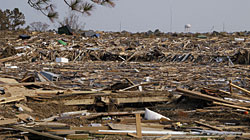
It is to be expected that the government is one of the first entities to begin bringing infrastructure services back on line, but Coursin anticipates other commercial business will follow suit in short order.
Contractors have also contacted the company asking for portable units in order to be ready for emergency operations. Ordinarily, the local independent manufacturer's rep would field most of those calls, but telephone communications have been out of commission.
"The local rep has been commuting to Jackson, about two to three hours away, just to be able to talk on the cell phone and receive e-mail," said Coursin.
The rep was only able to get back to his home office on Friday September 9. Though he did not experience any flooding, he did sustain roof damage.
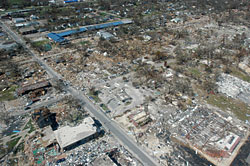
Status Of People And Companies
"The hurricane hit Chalmette, La., hard," said John Mott of Mott Associates, the company that provides press information for ICP, a Carrier Division that includes Heil and Tempstar brands. "It destroyed lots of houses" and is said to have left several feet of water in Guarino Distributing, a Heil products distributor there.Owner Gerry Guarino's wife went into labor during the hurricane, Mott said. He got her to a hospital in New Orleans and they have since relocated to Tampa-St. Pete, Fla. "Cindy, myself, our new baby Marissa, and Matthew are doing fine," Guarino said in a recorded message.
Keith Bienvenu, of Bienvenu Bros. Enterprises and a board member of Quality Service Contractors (QSC), reported, "All my family is safe and sound!
"I was able to get into Metairie [La.] on a temporary basis and survey the damage and it's bad," he told Charlie Wallace of the QSC.
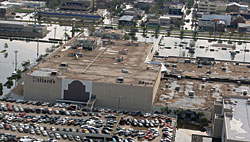
News is still trickling in about damage to specific companies.
"We have heard from all of our distributor customers in the area," said Doug Widenmann, senior marketing director, York UPG. "Our distributors have had less luck contacting their dealers.
"All of our distributors who serve the area have had significant losses in equipment and structures," he said. "Many of the distributors have other locations that are able to take in equipment and we have been working with them to move and replenish supplies."
According to Andy Fracica, York brand manager, "The York distributor in New Orleans, Colgan Distributors, had about two feet or so of water in their building. We are still not sure of the extent of the damage. Solar Supply, our Luxaire distributor, had major damage to several of their locations in and around New Orleans."
The manufacturer announced that its New Orleans service office has been temporarily relocated to Baton Rouge, La. (225-757-1070). New Orleans sales agent Schully Strawn & Associates has relocated temporarily to Gonzales, La. (504-831-0000; 800-345-9711).
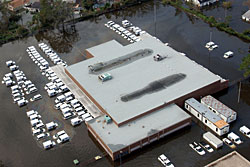
Highside Chemicals, Gulfport, Miss., announced that it had some building damage but it will be rebuilding soon. It expects to resume production within the month. In the meantime, the firm said it has finished goods to meet demand, limited by shipping capacity in the area. Call 800-359-5599 or 228-896-9220.
ABB North America established a Hurricane Katrina Task Force with a toll-free number for customers dealing with the storm's aftermath: 877-511-4222. Help Desk employees are available from 8 a.m. to 6 p.m. EDT. "After-hour calls will be handled by an outside service, which will use the same contact sheet and call procedures as the Help Desk employees," the company said.
Carrier HVAC Service's New Orleans office does have a working phone number: 800-256-9934. The number can be used for the entire Gulf Coastal area.
Publication date: 09/19/2005

Report Abusive Comment